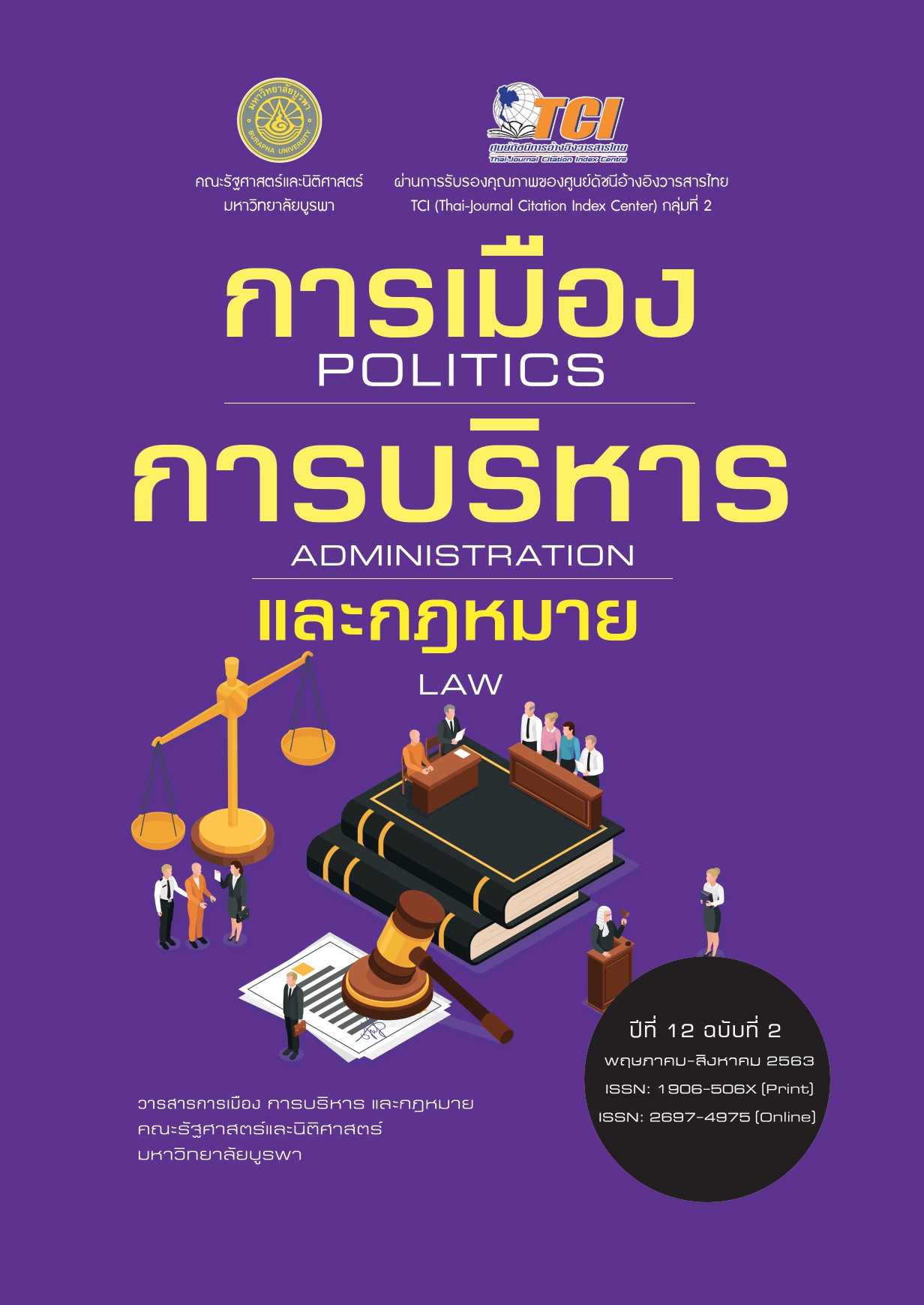A Study of Service Quality using SERVQUAL Model: a Case of Suvarnabhumi Airport Rail Link (SARL)
Keywords:
Service quality, SERVQUAL, Railway service quality, Services standardsAbstract
This study explores the factors influencing success of service quality for Suvarnabhumi Airport Rail Link (SARL) in Bangkok, Thailand through executives and experts’ aspects. The methodology is qualitative method. The target group is a group of 12 experts who have professional skills and cognitions in SARL. Then they were conducted a semi-structured in-depth interview based on SERVQUAL Model 10 dimensions for index of item objective congruence (IOC). After that, data were analyzed by content analysis divided into three parts: data reduction, data display, and conclusion interpretation. Triangular model was used to check the accuracy and then the analyzed data were interpreted for the conclusions. The findings show that the most impactful factors affecting SARL service quality in the views of executives and experts are Reliability, Assurance, Responsiveness, and Creditability. They also suggest that SARL itself is not able to handle the existing problems effectively because the regulations and rules prohibit the smooth operations and there are insufficient budgets for the maintenances and development; therefore, government should get involve to figure it out these obstacles. Experts recommend one of the popular practices in train operation and maintenance that Total Quality Management (TQM) of SARL should cover the quality of whole system and focus on train maintenance into three manners (predictive maintenance, preventive maintenance, and corrective maintenance) in order to maintain the service quality effectively for achieving the customer needs.
References
การรถไฟฟ้าขนส่งมวลชนแห่งประเทศไทย (รฟม.). (2557). คู่มือการบริหารความเสี่ยง. กรุงเทพฯ: การรถไฟฟ้าขนส่งมวลชนแห่งประเทศไทย.
การรถไฟฟ้าขนส่งมวลชนแห่งประเทศไทย (รฟม.) (2562). ประวัติความเป็นมาและการจัดตั้ง รฟม.วันที่ค้นข้อมูล 11 เมษายน 2562, เข้าถึงได้จาก https://www.mrta.co.th/th/about_mrta/history/
การรถไฟแห่งประเทศไทย (2560). รายงานประจำปี 2560. วันที่ค้นข้อมูล 11 เมษายน 2562, เข้าถึงได้จาก file:///C:/Users/Administrator/Downloads/81f27fd3481fec409512036bb4aced87.pdf
ขจรศักดิ์ บัวระพันธ์. (2555). การประเมินทักษะแห่งศตวรรษที่ 21. นครปฐม: สถาบันนวัตกรรมการเรียนรู้มหาวิทยาลัยมหิดล.
ธีรภัทร วีระวัฒน์โสภณ. (2555). ความพึงพอใจของผู้โดยสารที่มีต่อการใช้บริการรถไฟฟรีเพื่อ ประชาชน ขบวนรถเร็ว กรุงเทพมหานคร-เชียงใหม่. การศึกษาเฉพาะบุคคล, ปริญญามหาบัณฑิต, มหาวิทยาลัยเชียงใหม่.
บุญเลิศ จิตตั้งวัฒนา. (2535). การวิเคราะห์และวางแผนด้านการขนส่ง. กรุงเทพฯ: มหาวิทยาลัยรามคำแหง.
เบญจวรรณ นพบรรจบสุข. (2543). ความคิดเห็นของผู้ใช้บริการต่อการให้บริการโดยสารของ การรถไฟแห่งประเทศไทยเส้นทางสายเหนือ : กรณีศึกษารถด่วนพิเศษนครพิงค์. วิทยานิพนธ์บริหารธุรกิจมหาบัณฑิต, สาขาบริหารธุรกิจ, บัณฑิตวิทยาลัย, มหาวิทยาลัยเชียงใหม่.
มาริสา เจริญไพศาลสัตย์. (2553). ความพึงพอใจของผู้โดยสารรถไฟที่มีต่อการ. ให้บริการของขบวนรถด่วนพิเศษนครพิงค์กรุงเทพ-เชียงใหม่. การค้นคว้าอิสระ. มหาวิทยาลัยเชียงใหม่.
สถาบันบัณฑิตพัฒนาบริหารศาสตร์. (2544). การสำรวจความพึงพอใจของผู้ใช้บริการรถไฟแห่งประเทศไทย. กรุงเทพฯ: สถาบันบัณฑิตพัฒนาบริหารศาสตร์.
สำนักงานคณะกรรมการพัฒนาการเศรษฐกิจและสังคมแห่งชาติ (สศช). (2560). รายงานโลจิสติกส์ของประเทศไทยประจำปี 2560. กรุงเทพฯ: สำนักงานสภาพัฒนาการเศรษฐกิจและสังคมแห่งชาติ.
สำนักงานนโยบายและแผนการขนส่งและจราจร (สนข.). (2562). การพัฒนาการขนส่งและจราจร. วันที่ค้นข้อมูล 11 เมษายน 2562, เข้าถึงได้จาก https://www.otp.go.th/index.php/site/index
สวณีย์ คงเพชราทิพย์. (2545). ปัจจัยที่มีผลต่อทัศนคติในการใช้บริการรถไฟฟ้า BTS ของประชาชนย่านฝั่งธนบุรี. วิทยานิพนธ์บริหารธุรกิจมหาบัณฑิต, สาขาบริหารธุรกิจ, บัณฑิตวิทยาลัย,จุฬาลงกรณ์มหาวิทยาลัย.
สุนิภา งามสันติกุล. (2542). ความคิดเห็นของประชาชนต่อระบบรถไฟฟ้าขนส่งมวลชน : ศึกษาเฉพาะกรณีโครงการรถไฟฟ้ามหานคร. วิทยานิพนธ์บริหารธุรกิจมหาบัณฑิต, สาขาบริหารธุรกิจ, บัณฑิตวิทยาลัย, มหาวิทยาลัยเกษตรศาสตร์.
Airports of Thailand Public Company Limited. (2018). About AOT: History. Retrieved April 7, 2019, from https://www.airportthai.co.th/en/airports-of-thailand-plc/about-aot/histories/
Fontana, A., & Frey, J. H. (2000). The Interview: From Structured Questions to Negotiated Text. In Collecting and Interpreting Qualitative Materials. (pp. 645-672). Thousand Oaks, CA: Sage Publications.
Coogan, M. A. (1995). Comparing Airport Ground Access--A Transatlantic Look at an Intermodal Issue. TRNews, 181, 2-10.
Coyle, J., Bardi, E. J., & Novack, R. A. (1994). Transportation: A Global Supply Chain Perspective. USA: West Group.
Eisenhardt, K.M. and Martin, J.A. (2000) Dynamic Capabilities What Are They?. Strategic Management Journal, 21, 1105-1121.
FlytoGet. (2009). FlytoGet AS: Annual Report 2009, Retrieved April 7, 2019, from http://www.flytoget.no /eng/about-flytoget/ Annual-reports
Grant, R. (1991). A Resource Based Theory of Competitive Advantage. Strategy: critical perspectives on business and management. California Management Review. (3). 114-135.
Holstein, J., & Gubrium, J. (2003). Active interviewing. In Postmodern Interviewing. Thousand Oaks, CA: Sage Publications.
International Standard IEC62278. (2000). Railway applications - Specification and demonstration of reliability, availability, maintainability and safety (RAMS) Retrieved April 7, 2019, https://webstore.iec.ch/preview/info_iec62278%7Bed1.0%7Db.pdf
Parasuraman, A. P., Zeithaml, V. A., & Berry, L. L. (1988). A Conceptual Model of Service Quality and its Implication for Future Research (SERVQUAL). Journal of Marketing, 49, 41-50.
Pfeffer, J., & Salanick, G. R. (2003). The External Control of Organizations A Resource Dependence Perspective. NY: Harper & Row.
Priem, R. & Butler, J. (2001). Is The Resource-Based View a Useful Perspective for Strategic Management Research?. The Academy of Management Review, 26(1), 22.
Robinovitch, J. (1996). Innovative land use and public transport policy: The case of Curitiba Brazil, Land Use Policy, 13(1), 51-67.
Robinovitch, J., & Leitman, J. (1996). Urban Planning in Curitiba. Scientific American, 26-33
Shen, W., Xiao, W., & Wang, X. (2015). Passenger satisfaction evaluation model for urban rail transit: A structural equation modeling based on partial least squares. Transport Policy, 46, 20-31.
Silverman, D. (1993). Beginning Research. Interpreting Qualitative Data: Methods for Analysing Talk, Text and Interaction. Londres: Sage Publication.
Stalk, G., Evans, P., & Shulman, L. (1992). Competing on Capabilities: The New Rules of Corporate Strategy. Harvard Business Review, 70, 57-69.
Williams, R. J. (1992). Simple statistical gradient-following algorithms for connectionist reinforcement learning. Mach Learn, 8, 229–256.






